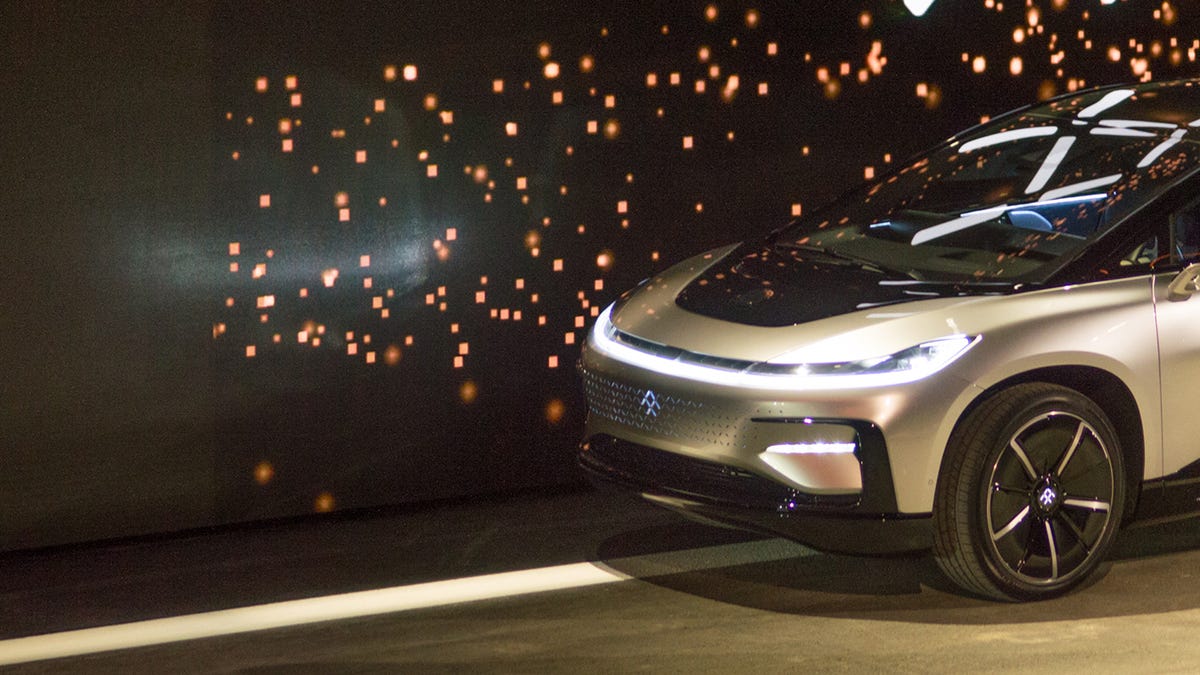Faraday Future finally fills us in on the 1,050-horsepower FF 91
After much ado, the beleaguered EV startup shows off its first production vehicle at CES 2017.

It's done it. Today, electric car startup Faraday Future debuted its first electric vehicle, dubbed the FF 91, at CES 2017 here in Las Vegas. After a disastrous showing at last year's CES, when the company showed off a nonfunctional EV supercar instead of the expected production vehicle, the pressure was on for it to follow through with something we could actually, you know, buy.
Faraday Future has been getting some, ahem, press of late, with reports of senior employees jumping ship, delays of its $1 billion dollar factory in Nevada due to unpaid bills and debts in the hundreds of millions of dollars.
Still, the company put on a pretty face in late December during a tour of its Los Angeles headquarters. After only two and a half years since its founding, Faraday Future now boasts 1,400 employees and 194 patents filed. The company has grown by leaps and bounds, but to date hasn't had much to show for it other than a series of teaser videos.
Until now. Twelve prototypes of the 1,000-horsepower, all-wheel-drive EV have been completed and I got to ride shotgun for a 1-minute jaunt around a parking lot. It's tough to give an evaluation based on such a quick ride, and engineers admitted that the car was not yet up to production caliber, but the car seems to handle fairly well, albeit with some body roll. It's helped along by about 3.5 degrees of rear-axle steering, and while engineers wouldn't give any specifics on weight or torque, the in-house electric drivetrain can motivate the FF 91 to 60 mph in 2.39 seconds. If you're keeping track, that's just a smidge below the 2.5 seconds for a Tesla Model S P100D with Ludicrous Mode.
Faraday Future promises the FF 91 will have a range of 378 miles, but the company was cagey when asked about charging infrastructure. It hemmed and hawed when asked about a network like Tesla's Supercharging system but confirmed today that the FF 91 has the ability to charge at more than 500 miles per hour.
Faraday Future wants the FF 91 to be the most connected car available, keeping track of passengers' personal settings regardless of which seat they're sitting in. Screens will be ubiquitous, with a large horizontal screen for rear passengers, displays in the doors, a screen for both driver and passenger and a high-resolution digital rearview mirror.
Passengers in the back will also be treated to seats that lay nearly flat. It's a neat trick, but honestly, when I tried it out, I just felt like I was at the dentist.
While the FF 91 will feature autonomous driving, with 3D lidar, 10 high-definition cameras, 13 long and short range radars and 12 ultrasonic sensors, I was only able to witness the self-parking system. At the time it could only back into a parking spot on the right side and the system only works with private parking lots, as the locations must be mapped and verified. Faraday Future hopes to use crowdsourcing to verify public parking lots across the US, and presumably the world.
On the outside, the FF 91 will use different light signatures to indicate driving modes. Faraday Future logos on the lower cladding can change both intensity and color, using blue for charging and a white scrolling pattern when the car is in autonomous mode.
Batteries will be provided by LG Chem, the same company that worked with General Motors to develop the Chevrolet Bolt EV's capacious battery pack. The scalable modular battery platform should allow Faraday Future to produce different sized vehicles.
Faraday Future plans to deliver production vehicles in 2018, but currently the company's factory exists only on paper. While the site in Nevada has been leveled, there are no buildings yet. While the technology of the FF 91 looks promising, with no means of actually producing the thing, it's still easy to be skeptical about when, and indeed if, we'll see actually see the thing on the roads.
Is this our future?

